13 August, 2023
The Linear Trail is exactly what its name implies, a straight trail, rather than a loop. It has been our custom over many years to start at the same end, but we decided it was time for a change and we began our walk at the other end. We were joined by Lisa and we set off together in high spirits.
A Blue Jay (Cyanocitta cristata) was there to welcome us.]
Angelica (genus Angelica) was doing well.
The characteristic larvae of Fall Webworm Moth (Hyphantria cunea) were almost in plague proportions!
Dryad's Saddle (Cerioporus squamosus) is a very common fungus; my hand will give you an idea of the size of this specimen.
When you really start to look, it is quite startling how many plants are affected by Gall and Rust Mites (family Eriophyidae).
I am sure that those who suffer from hay fever shudder at the mere thought of Giant Ragweed (Ambrosia trifida), but it was robust and healthy in several spots along the trail.
These Mallards (Anas platyrynchos) are probably all that remains of a family that started out with as many as eight or ten ducklings. There are so many predators of these young birds.
One of my favourite books on waterfowl is the classic (my judgment) work The Ducks, Geese and Swans of North America by that great Canadian naturalist, F.H. Kortright. The language is quite lyrical and I was struck the other day when looking at this book for the sheer of pleasure of doing so, by the phrase, "The Mallard is a great destroyer of mosquito life." Styles do change, don't they?
Since featuring Jerusalem Artichoke (Helianthus tuberosus) on a recent post I have gathered that people either love it or hate it. Several have commented that it tends to cause excessive flatulence, while others say it makes divine soup. Perhaps both are true. Regardless, its flower is beautiful.
As we move ever closer to Fall, fungi are starting to pop up here and there, and I thought this False Puffball (Reticularia lycoperdon) exceptionally attractive.
As you might imagine, we were thrilled to see a Cedar Waxwing (Bombycilla cedrorum), surely one of Ontario's avian superstars.
The highly invasive, rapidly spreading Common Buckthorn (Rhamnus cathartica) is a legacy from early European settlers we would prefer not have been bequeathed.
The berries are highly valued by numerous birds species, especially American Robin (Turdus migratorius), but they have a strong laxative effect, so that seeds are dropped in the vicinity where they were consumed and dense, impenetrable stands of buckthorn develop quickly and exclude native species. (Note added 04 September - All credit to Lisa who alerted me to the fact that this conventional wisdom about buckthorns and its excessive cathartic effect is unsupported by evidence, and indeed I have been unable to find any. The literature is full of references to this alleged condition, but it seems to have been a supposition passed down, thereby acquiring the mantle of truth. In fact, buckthorns seem to have no more laxative consequences than other fruit. As Christopher Hitchins so wisely remarked, "What can be asserted without evidence can be dismissed without evidence." Thanks for your dedicated sleuthing, Lisa).
A squirrel drey is not needed for warmth at this time of the year, but is no doubt still jealousy guarded by its owners.
My probing tells me that this very attractive plant is a species of Onion (genus Allium) but I am unable to tell you more than that.
Red-spotted Purple (Limentis arthemis astyanax) is always a welcome sight, fluttering on large wings, or perching for a photograph.
It will not be long before this female Rose-breasted Grosbeak (Pheucticus ludovicianus) is stirring for migration.
Where there had previously been one Cedar Waxwing there were now two, perhaps attracted by the insects trapped in a spider's web.
We had by now reached the area known as The Confluence where the Grand and Speed Rivers join together. This is about half way along the Linear Trail and we usually come this far from the other direction.
A Double-crested Cormorant (Nannopterum auritus) took off upstream perhaps in search of better hunting.
It is a stinging parasitoid species that paralyses its prey (caterpillar, spider, cricket etc) upon which it lays an egg. The living, but immobilized prey is food for its larva when it emerges from the egg.
A Blue-fronted Dancer (Argia apicalis) is in no danger from a mud-dauber wasp.
Perhaps we have just not seen many, but Eastern Tiger Swallowtail (Papilio glaucus) seems to be quite rare this year.
Eastern Calligrapher (Toxomerus germinatus), a small hover fly, on the other hand is numerous and not hard to find.
Just before leaving the trail and returning to the car a Least Skipper (Amcyloxypha numitor) put in an appearance, as though to say, "Goodbye. Come again soon."




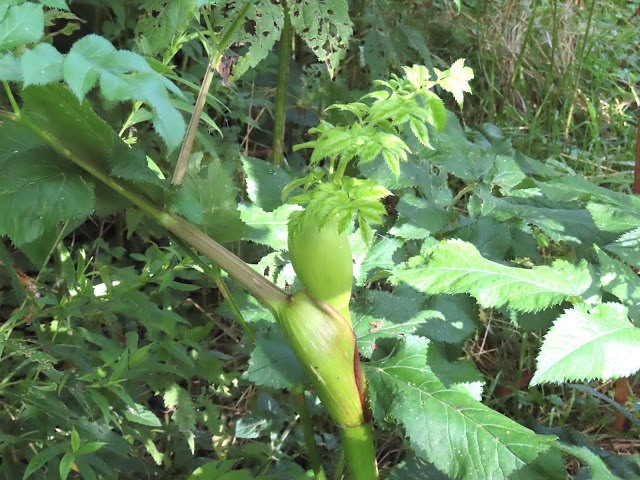


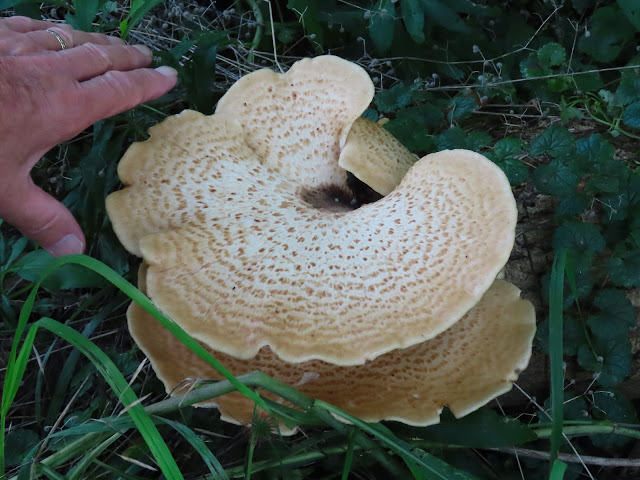



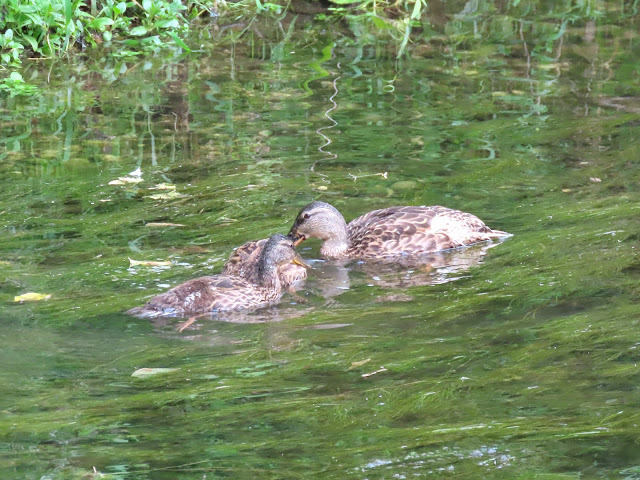

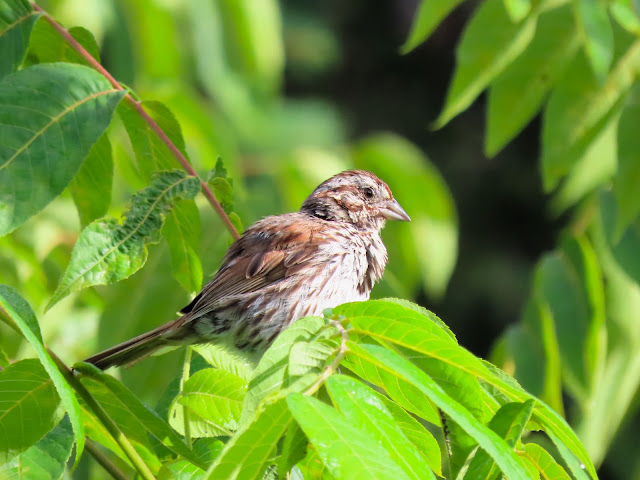











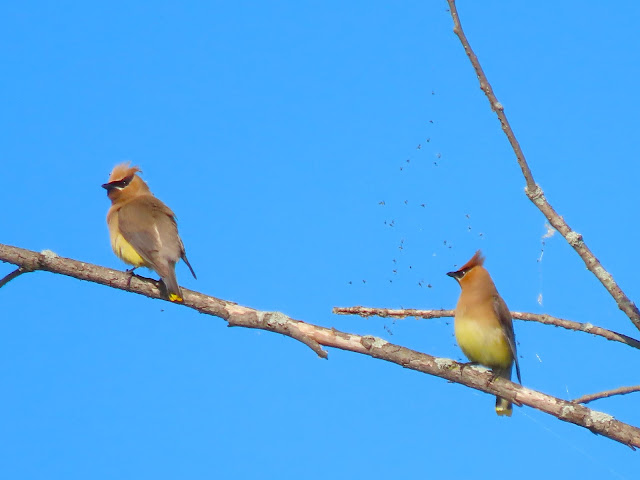


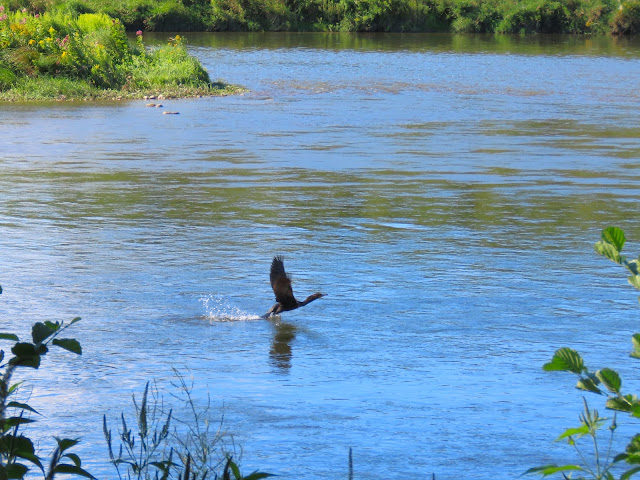









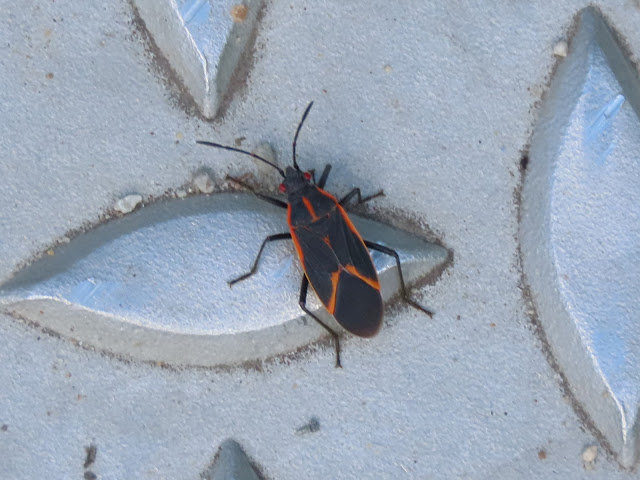




















Hari OM
ReplyDeleteOh I do love all the insect shots - it can be easy to overlook how beautiful they are in their own way! And it always amazes me how the road travelled in the opposite direction can such different views... YAM xx
I agree with YAM!
DeleteWhat a wonderful trail and another amazing selection! I love the glimpse of the Swallowtail!
ReplyDeleteWe have still not seen many of them this year, so it appears not to be a good one for them. I know of no reason for this outcome.
DeleteHi David.
ReplyDeleteBeautiful nature.
Too bad about those plants that have been affected.
Beautiful Butterflies, Flowers and Birds.
Greetings from Patricia.
Ah, to be able to scatter all those latin names (ornithological dandruff) about the place,. inducing a sense of sauve qui peut among your readers. I was, for a short while, a member of the RSPB (I'm assuming the initials are enough for you) and was genuinely drawn to the thrills of pursuit. A hen harrier was my most rewarding find but like all beginners I was never able to come to terms with the recurrent problem of "so many little brown birds". I needed someone more experienced to guide me and never found one. I think I saw nature as a branch of geology which is a fancy way of saying I did rock-climbing at a modest level until removal to London and an increasingly unfavourable size-to-weight ratio indicated I'd be better off ski-ing, later longish distance swimming.
ReplyDeleteI was a journalist, latterly specialising in the art/science/practice of logistics and I too roamed the world. More recently the implications of age have dominated what I do. I worked for 44½ years yet I've been retired for nearly thirty years and more sedentary activities beckoned. I've published two novels, a collection of short stories and a primer on learning to sing classical music which I Iook up aged eighty. I've blogged since 2008 and many of my commenters have fallen away because they found me too argumentative.
I was badly educated, leaving school and entering a state of euphoria (ie, a newspaper reporter's room) at 15. Almost all my present commenters are better educated so I do what journalists do: make little bits of a lot go quite a long way. I will add your name and blog to my list, knowing quite well my tendencies towards facetiousness may eventually cause a rift. I like what little I've seen a Canada and I applaud what I perceived as the country's desire to distinguish itself - mainly via that extra language, one of my all-time enthusiasms - from its more powerful neighbour to the south (where I worked for six years). I admire learning provided it is seasoned by a regular desire to lauigh.
I replied to your comment on Tone Deaf
It’s a pleasure to read your comment and I look forward to an entertaining dialogue between us (easy for you, a challenge for me). Bilingualism is indeed a great distinguishing feature of this country. I used to live in Québec City and my daughter was born there. She now lives in Ottawa and we always enjoy our bilingual experience when we visit. It’s the only opportunity I get to flex my French these days. A bientôt, mon ami.
DeleteAnother great report and walk. Beautiful nature photos! My favorites are the Cedar Waxwings and the Cormorant taking off. Happy birding! Take care, have a great day and happy new week!
ReplyDeleteI'm so impressed with all the different things you see on a walk, David. I understand why the ducks produce so many offspring when so few survive. Helianthus tuberosus is a very beautiful flower. It is related to the common sunflower, and it is easy to see the relationship when you look at the flowers.
ReplyDeleteHugs and kisses, Marit
Go to the top of the class! Hugs and kisses - David
DeleteThere are two things that I absolutely HATE: mosquitoes and flies. Cedar Waxwing look so beautiful.
ReplyDeleteHe disfrutado de la belleza de esos lugares, pero me ha dado mucha pena de las plantas infectadas por la enfermedad.
ReplyDeleteUn abrazo
...I find Common Buckthorn interesting, it's one of several invasive plants in this area that deer don't eat. This year Eastern Tiger Swallowtail is the most common butterfly here. Thanks for sharing all of your observations.
ReplyDeleteWhat a beautiful series of photos of this nature walk David.
ReplyDeleteVery special that the leaves look like this because of the gall and rust mites, I have never seen this before.
The young sparrow is really cute.
I love the spider.
I enjoyed your photo.
Greetings Irma
I always dreaded the time of year when those creepy webs show up everywhere. even though I know they will not harm me, i don't like them. your photos of insects always show me details I never knew was on them. they are pretty amazing once seen. those berries, daddy had some on the front of the house, not buckthorn but I can't remember the name, and it had red berries and each year when the berries came the birds swarmed and left deposits every where on the property. I like a linear trail, because when I turn around it looks entirely different from the other way and I find things I did not see when I passed the first time
ReplyDeleteOnce again, a fabuloius mix of subject matter in this post, David. I was most truck by that Tiger Bee Fly. The few species of Bee Fly that we have in UK are very 'ordinary' compared to that one.
ReplyDeleteI am slightly concerned that the presence of avian subjects seem to be diminishing on your blog. I'm hoping that it is because it's a bit of a doldrum season and that soon fall migration will bring you plenty of wonderful birds to show us.
My very best wishes to you and Miriam - - - Richard
Not to worry, Richard. Migration has started now and birds are becoming a little more visible. We had a couple of walks recently where there were warblers, vireos and flycatchers present, but the trees still have dense foliage and it's hard to get pictures. That should all change soon. On Thursday we will be leaving for a week on Vancouver Island with Selwyn and Victoria, and that will be pretty much solid birding, with so many coastal species where foliage is not an issue. Yesterday a hummingbird visited our backyard feeder repeatedly and Miriam was able to get some decent shots.
DeleteLate summer/early fall is always great for fungi and galls. But they are always interesting to find. I am surprised with all the rain we had we don't have mushrooms everywhere, but perhaps they are still coming. And thanks for the Maddie returning to health wishes. We were saying that luckily we don't have any trips planned because we would have to cancel them, not only to care for her but to pay for the hospital bills. Hopefully, no surgery and she'll be home in another day or 2. Enjoy your weekend David. hugs-Erika
ReplyDeleteAnother great hike with you David, I always come away feeling I learned something new. Thank you!
ReplyDeleteXO
WWW
The huge webs of the tent worms really creep me out. I remember a neighbor had one of their trees when I was a kid and watching the millions of them (looked like to a kid) crawling around inside of it...gave me the willies. But, as usual, there are many other beautiful things to look at on one of your walks. ;)
ReplyDeleteThe picture of the river shows that's a beautiful place. Sorry to see many plants are affected by such abnormal outgrowths.
ReplyDeleteInteresting post and great photo of the Tiger bee fly (It seems that insect lives in North America only).
Wonderful series of photos as always! My favorite would be the song sparrows and waxwings, as insects have always and continue to creep me out.
ReplyDeleteI had a visit from a blue jay yesterday in my evergreen out front but it wouldn't settle long enough for me to grab the camera to get a photo.
The fall web worm made an appearance recently too, in the city-owned tree in the front yard. I called the city office and someone came out and dealt with the web. I'd hate to lose a tree.
Beautiful photos of nature. I enjoyed the butteflies, we haven't seen many here this year. The flowers are always pretty to see. Thanks for taking us along for the hike, David.
ReplyDeleteTo look at things from the other end of the trail gives new views on landscape and its inhabitants. A good idea! David.
ReplyDeleteRegards,
Roos
Apart from that wasp and the spider, you saw some interesting things.The photos Miriam takes are always fabulous! Hugs, Valerie
ReplyDeleteThank you both. So very much.
ReplyDeleteIt looks a nice trail and many thanks for sharing your sightings, a good variety.
ReplyDeleteEnjoy your September days.
All the best Jan
I didn't know those spots on plants are bugs! I always learn something from you, my friend. I knew they weren't good, though. The terrible heat has made some of our plants happy and made others suffer.
ReplyDeleteLove,
Janie
David, I went to get my hair cut yesterday and a very sad Canada goose was in front of the salon. The workers there had given him water and some bird seed and lettuce. They explained he didn't have webbing on one of his feet and had difficulty moving. A bird sanctuary wouldn't come to pick him up, and they weren't allowed to take him to the sanctuary because Canada geese are a protected species. They were told to get him to water and he'd be fine, but had no way to do so. How can they help him? It's quite a quandary.
DeleteI love your pictures of the bugs!!........Abrazotes, Marcela
ReplyDeleteEnjoyed being taken along on your walk. You solved a mystery for me (I think) - all over some parts of a local rail trail right now is what I would call (maybe) bird scat full of seeds and seeing to come from a purple/black berry. And, many times, we see American Robins on grassy areas of the trail. I've wondered what was leaving this and what the berries (I figured it was some kind of berry) were. Alana ramblinwitham.blogspot.com
ReplyDeleteSo much to see on that trail, David. I’ve seen tents of that moth before. They are rather an incredible creation!
ReplyDeleteThe Black Ducks which inhabit the salt marsh every spring are lucky to have any of their ducklings survive. One of five made it this year. Last year, none survived.
Love the colours of the insects. Quite the creatures!
Hey chicos, que tal, whatsup!, loved this serene day on the Linear Trail -except for the spider and the infested plants, everything is beautiful there. Gorgeous the Grand River panorama!
ReplyDeleteI´m wishing you a beautiful month of September ahead, lots of hugs and kisses!
Lovely to see a couple of sparrows. They are the most polite little birds.
ReplyDeleteA few insects there and looking interesting, it's not good when 'things' come and take over the plants and ruin leaves but I suppose these have to live too.
ReplyDeleteTravelling in the opposite direction is like a completely different walk. The coming autumn brings with it so many new things to see such as that fungi. Loved all the different insects you highlighted.
ReplyDeleteBeautiful pictures !!! You are a "encyclopedia" on your own David ;)
ReplyDeleteAnd an "eye" to find beautiful and hiding species of plants, birds and insects !
Have a nice September !
Anna
I looked up phylloxera caryaesemen and thought it said 'tree bugs' – made sense looking at the pic … but realised they were of the true bugs (the species of this huge genus) gave me a laugh …
ReplyDeleteThe tent-making moth reminds me of the Bird Cherry Ermine moth we get here; Appropriate name for the Giant Ragweek is Ambrosia trifida; Jerusalem artichoke: both are true! love the colour of its flower though.
The spread of introduced plants is a sad indictment on the human race as it explored. The petrophila moth is delightful to look at, as too the Eastern Calligrapher – wonderful names they have. Tiger Bee Fly – also, as too the greenbottle fly …
Always a delight to read … cheers Hilary
And always a delight to hear from you, Hilary.
DeleteHi David,
ReplyDeleteTo walk a trail in the opposite direction than you normally do gives most of the times a complete different view over the environment. Many times I let the direction of the wind be my guide. The variety of wildlife is also along this trail attractive. So all the ingredients for a perfect stroll were available.
Greetings, Kees
What fabulous fungi! Pity that this bug is all over the plants -- and doesn't seem to care much which plants it is on. At first I thought it was a beautiful, spotted leaf. Not now.
ReplyDeleteA lot of beautiful things to see along that trail.
ReplyDeleteI like a lot the photo of the spider. Some years ago a spider decided to "build his house" in my bedroom; we called him Ugo and he lived with us one and half year: we never disturbed him.
Beautiful photos. I think the trail is a very long distance. You saw a lot of beautiful things.
ReplyDeleteNot too long, Caroline - about 4 km.
DeleteLovely series as always David...Super pictures and your dialog never disappoints..I have only seen one Swallowtail this year..Quite unusual.
ReplyDeleteWe have seen quite a few Black Swallowtails, and Giant Swallowtails too, but Eastern Tiger Swallowtail has been quite elusive.
DeleteI am enjoying the mixture of insects, plants and avian, but I am guessing that you will soon be short of insects as it gets colder and the birds will appear.
ReplyDeleteOur Jerusalem Artichoke it still in bud and it as about 2 1/2 metres high. As it starts flowering I pick the flowers for the house so the growth goes into the roots instead of the flowers.
Sorry I am not doing a very good job of keeping up. We have so many figs at present that I am trying to dehydrate, and then the apples, quinces and meddlers will be next. That is not even bringing all the vegetables into the equation!!!
Take care. Bisous mon ami, Diane
DeleteYou are quite right, Diane, bug season will soon be over, but bird life is picking up now as migration gets underway in earnest. Bisous - David
Hi David.
ReplyDeleteBeautiful birds show you.
Beautiful nature.
Too bad about those leaves with those fungi.
Greetings from Patricia.
Beautiful photos. I love waxwings, I've only seen one in my life (European).
ReplyDeleteBest wishes.
Cedar Waxwing is quite common here. Always delightful.
DeleteLots to see on this trail, especially if you look closely at the small stuff. The fungus was my favorite.
ReplyDeleteAutumn is coming.
ReplyDeleteMuchos árboles se están perdiendo también por aquí David . Buen despegue hizo el cormorán. Gusta ver tus intereantes fotos naturaleza
ReplyDeleteQue tengáis un buen septiembre.
Un abrazo.
It looks like the insects are thriving.
ReplyDeleteIn fact they are not; most species are declining at worrisome rates.
DeleteI find myself looking intently at each photo. A great series of nature David. Thank you!
ReplyDeleteAnother brilliant walk through nature. Fantastic series of photos, especially interesting the photos of the insects.
ReplyDeleteI remember well my first sighting of a Cedar Waxwing. He was in our mulberry tree, and I was delighted when I realized there was a whole flock of them in the tree! I never get over the thrill when they return each year.
ReplyDeleteThis post is the first time i have ever actually seen the Latin name for Blue Jays! What an odd thought. They have been abundant wherever I have lived but I never thought about their scientific name.
As for the Eastern Tiger Swallowtail, I think they must have all stayed down here in the lower 48, as we have seen many in our gardens this past month.
Such a fascinating trail!
ReplyDeleteLove the gorgeous nature photos.
hello David
ReplyDeleteno leaf or angle left out and always found something exciting, the tiger bee fly is a very interesting insect, never seen before.
Greetings Frank
Hello David
ReplyDeleteThese wetlands are wonderful, there are so many tall trees on the banks of the river it's a joy to behold.
I'm sad because I've never met the Waxwing.
On the other hand, I hope to see a cardinal in January in Yucatan.
Thank you for this morning walk.
Big kisses to both of you dear friends.
Glad to be back and join you on one of your nature walks. That spider, though -- eek!
ReplyDeleteKolejna wspaniała porcja z obserwacji w terenie. Dziękuję Wam za to. A szczególnie za zdjęcia jemiołuszek, których dawno nie widziałam. Pozdrawiam serdecznie!
ReplyDeleteQuite a lot of birds.
ReplyDeleteComo siempre me encantó pasear contigo. Abrazos.
ReplyDeletethe web worms were definitely in plague proportions here and they completely defoliated quite a few mature pecan trees at the other end of my street. fortunately they were waning by the time they got to my end and my trees only had a few webs.
ReplyDelete